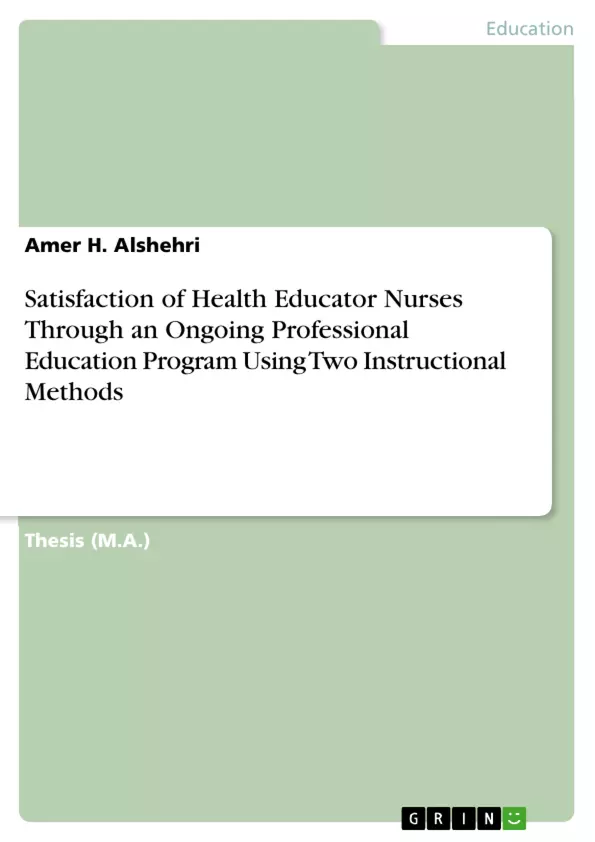The aim of the study was to determine whether the interactive teaching method is more effective than the lecture-based method with regard to the nurse educator’s satisfaction and learning. No local study has been conducted in this area in health educational training programmes in the primary health care setting. The results of this study will help administrators of health education programmes to evaluate the desirability of implementing interactive methods in health education and training.
The study was conducted between January and June 2008 in the Dammam area of the Kingdom of Saudi Arabia. The study was a cross-sectional study that sought to identify the perceptions of health educator nurses; of the 40 invited to participate, 34 nurse educators from 20 primary health care centers attended. The 34 participants were divided in two groups by simple random tables. The quantitative method of data collection, through the use of a two-part questionnaire, was employed.
The mean age of the nurse educators was 35.2 ± 6.9 years. There was a statistically significant difference between the traditional and interactive methods in10 items out of the 22-item questionnaire (higher scores toward interactive method). There was also a significant difference in participants’ preference for the interactive method over the traditional lecture-based method. In addition, significantly better scores for course content and student satisfaction resulted from use of the interactive method. No single factor among the demographic characteristics was found to significantly affect the total differences in score of participant`s perceptions.
Nurse educators in primary health care centers prefer an interactive teaching method and peer teaching over the traditional lecture-based method of instruction. There is a need to train nurse educators to become effective presenters using interactive methods. Updating nurses’ knowledge in interactive teaching and the use of peer teaching is, therefore, important in continuing medical education programs for health professionals.
Inhaltsverzeichnis (Table of Contents)
- Abstract
- Introduction
- Literature Review
- Methodology
- Participants
- Instruments
- Data Collection
- Data Analysis
- Results
- Discussion
Zielsetzung und Themenschwerpunkte (Objectives and Key Themes)
This thesis investigates the effectiveness of interactive teaching methods compared to traditional lecture-based methods in health education programs for nurse educators in primary health care settings. The study aims to determine if interactive methods, specifically peer teaching and problem-based learning, enhance nurse educators' satisfaction and learning.
- Nurse educators' satisfaction and learning outcomes in health education programs
- The effectiveness of interactive teaching methods (peer teaching and problem-based learning)
- Comparison of interactive methods to traditional lecture-based instruction
- The impact of different instructional methods on nurse educators' perceptions of course content and satisfaction
- The potential for improving health education training through the implementation of interactive methods
Zusammenfassung der Kapitel (Chapter Summaries)
- Abstract: This chapter provides a concise overview of the study's objectives, methodology, findings, and conclusions, highlighting the preference for interactive teaching methods among nurse educators.
- Introduction: This chapter establishes the context and rationale for the study, addressing the need for effective health education training programs in primary health care settings and the potential benefits of interactive teaching methods.
- Literature Review: This chapter provides an extensive overview of relevant research and theories related to adult learning, instructional methods, and nurse education, highlighting the advantages of interactive methods in promoting active learning and engagement.
- Methodology: This chapter outlines the study's design, sample, data collection methods, and data analysis procedures, describing the use of a two-part questionnaire and a paired t-test to compare nurse educators' perceptions of the two instructional methods.
- Results: This chapter presents the quantitative data collected through the questionnaire, focusing on the comparison of nurse educators' responses to the traditional lecture-based method and the interactive method, highlighting the statistically significant differences in satisfaction and learning outcomes.
- Discussion: This chapter analyzes and interprets the findings, discussing the implications of the results for health education program administrators and the need for training nurse educators in interactive teaching methods.
Schlüsselwörter (Keywords)
This study focuses on health professions education, nurse education, interactive teaching methods, peer teaching, problem-based learning, traditional lecture-based instruction, nurse educator satisfaction, learning outcomes, primary health care, and the Kingdom of Saudi Arabia. The study aims to contribute to the understanding of effective instructional strategies in health education programs and to promote the use of interactive methods in nurse education.
- Citar trabajo
- Amer H. Alshehri (Autor), 2010, Satisfaction of Health Educator Nurses Through an Ongoing Professional Education Program Using Two Instructional Methods, Múnich, GRIN Verlag, https://www.grin.com/document/494233



